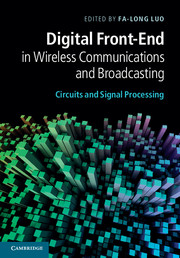Book contents
- Frontmatter
- Contents
- Contributors
- Preface
- Part I Introduction to digital front-end
- Part II DPD and CFR
- 6 General principles and design overview of digital predistortion
- 7 Power amplifier nonlinear modeling for digital predistortion
- 8 Look-up table based digital predistortion schemes and implementation
- 9 Digital predistortion and its combination with crest factor reduction
- 10 Adaptive digital baseband predistortion
- 11 Crest factor reduction techniques
- Part III DUC, DDC, ADC, DAC, and NCO
- Part IV Digital calibration, imbalance compensation, and error corrections
- Part V Circuits and system integration in digital front-end
- Index
- References
6 - General principles and design overview of digital predistortion
from Part II - DPD and CFR
Published online by Cambridge University Press: 07 October 2011
- Frontmatter
- Contents
- Contributors
- Preface
- Part I Introduction to digital front-end
- Part II DPD and CFR
- 6 General principles and design overview of digital predistortion
- 7 Power amplifier nonlinear modeling for digital predistortion
- 8 Look-up table based digital predistortion schemes and implementation
- 9 Digital predistortion and its combination with crest factor reduction
- 10 Adaptive digital baseband predistortion
- 11 Crest factor reduction techniques
- Part III DUC, DDC, ADC, DAC, and NCO
- Part IV Digital calibration, imbalance compensation, and error corrections
- Part V Circuits and system integration in digital front-end
- Index
- References
Summary
Introduction
Wireless communication systems use radio frequency (RF) signals to transmit data between base stations and mobile users. The RF power amplifier (PA) is located within the transmitter and is a key component of the down-link connecting the base station to the mobile. Power amplifiers tend to be either linear or efficient, but not both. Fortunately, an efficient power amplifier may be used within a digital transmitter if the nonlinear behavior of the PA is compensated using digital predistortion (DPD).
This chapter discusses digital predistortion techniques suitable for use in a digital transmitter. Section 6.2 reviews the nonlinear behavior of a power amplifier and its effect on the output spectrum. Section 6.3 provides an overview of digital predistortion avoiding equations for the most part. Details of the basic algorithms used appear in Section 6.4. Section 6.5 discusses some advanced topics in DPD.
- Type
- Chapter
- Information
- Digital Front-End in Wireless Communications and BroadcastingCircuits and Signal Processing, pp. 143 - 191Publisher: Cambridge University PressPrint publication year: 2011
References
- 24
- Cited by



